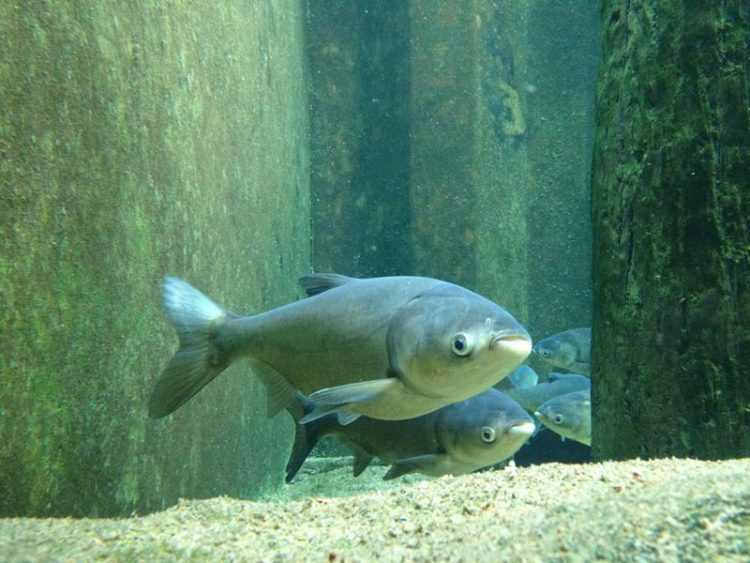Model offers more ease, precision for managing invasive Asian carp

Asian carp are migrating towards the Great Lakes and are threatening to invade this ecosystem, creating is an immediate need to control their population. Credit: Tatiana Garcia, USGS
Results illustrate the highest percentage of Asian carp eggs at risk of hatching occurs when the streamflow is low and when the water temperature is high. This new study by the University of Illinois and the U.S. Geological Survey (USGS) is published in the Journal of Great Lakes Research.
“In this study, the Fluvial Egg Drift Simulator (FluEgg) model allowed us to examine the complex dependencies between flow, temperature, and egg development,” said USGS hydrologist Ryan Jackson. “This information provides resource managers with a range of conditions under which the St. Joseph River is vulnerable to Asian carp reproduction.”
The FluEgg model was used to evaluate egg movement and the likelihood of successful Asian carp reproduction under different streamflow and temperature conditions representative of historical spawning seasons in the St. Joseph River, a tributary to Lake Michigan. Results show that eggs develop faster at warmer water temperatures, therefore requiring less time to drift in the river until hatching.
Low streamflows can also be conducive to reproduction when the streamflow is just fast enough to keep most of the eggs in suspension while allowing for the greatest amount of drift time before reaching the lake, thus increasing the likelihood of hatching.
The FluEgg model, developed by University of Illinois researchers in collaboration with the USGS, was first introduced in 2013. The latest version of the model is available online and includes a user-friendly interface and improved predictions of egg transport in rivers.
Invasive Asian carp consume plankton from the base of the food web and reproduce prolifically which could pose substantial environmental risks and economic impacts to the Great Lakes if they become established.
“This work focuses on the early life stages of Asian carp,” said USGS research fish biologist Duane Chapman. “Targeting early life stages can include disrupting spawning activities or egg development in rivers where Asian carp spawn.”
Several factors affect the viability of the eggs. The temperature of the water affects how long the eggs need to hatch, and the velocity of the river affects the movement of the eggs and whether the eggs remain in suspension or sink to the bottom. Eggs that settle on the riverbed will likely die, and eggs that are transported down the river and into a lake may not have enough time to develop to the hatching stage before settling to the lakebed.
The reproduction assessment of Asian carp eggs in the St. Joseph River demonstrated the complexity of the problem where the length of the river, velocity and water temperatures cannot be assessed individually. Rather, a holistic analysis is required, where egg development, water-quality characteristics and the hydrodynamics of the river are interconnected and analyzed together.
“Successful reproduction requires a fine balance between the rate of egg development and the variable flow conditions present in a river required to maintain the eggs in suspension,” said Tatiana Garcia, USGS research hydrologist and lead author of the paper.
###
The paper, “Application of the FluEgg model to predict transport of Asian carp eggs in the St. Joseph River (Great Lakes tributary)” by Tatiana Garcia, Elizabeth A. Murphy, Patrick R. Jackson, and Marcelo H. Garcia, is available online.
Media Contact
All latest news from the category: Ecology, The Environment and Conservation
This complex theme deals primarily with interactions between organisms and the environmental factors that impact them, but to a greater extent between individual inanimate environmental factors.
innovations-report offers informative reports and articles on topics such as climate protection, landscape conservation, ecological systems, wildlife and nature parks and ecosystem efficiency and balance.
Newest articles

Bringing bio-inspired robots to life
Nebraska researcher Eric Markvicka gets NSF CAREER Award to pursue manufacture of novel materials for soft robotics and stretchable electronics. Engineers are increasingly eager to develop robots that mimic the…

Bella moths use poison to attract mates
Scientists are closer to finding out how. Pyrrolizidine alkaloids are as bitter and toxic as they are hard to pronounce. They’re produced by several different types of plants and are…

AI tool creates ‘synthetic’ images of cells
…for enhanced microscopy analysis. Observing individual cells through microscopes can reveal a range of important cell biological phenomena that frequently play a role in human diseases, but the process of…





















